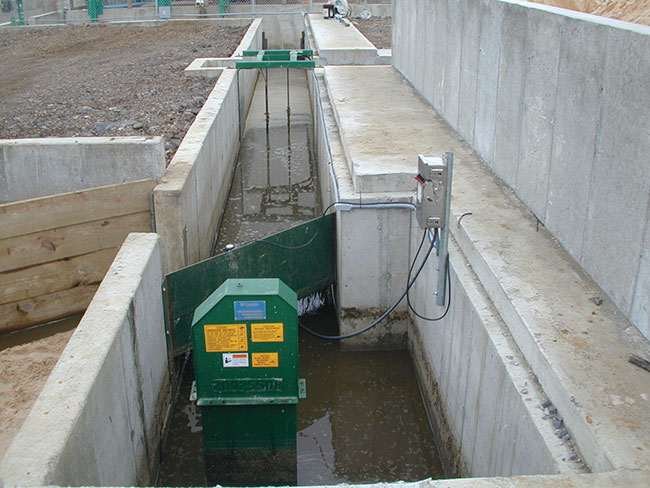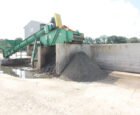Sand is among the more popular bedding materials for dairy cattle. Proponents of sand bedding say provides positive health and productivity benefits for milk production. It is also a cost-effective and healthy bedding alternative compared to other options, such as sawdust, wood shavings, and manure solids.
But one downside of using sand for livestock bedding occurs after it has been contaminated with manure. Dealing with this contamination and figuring out what to do with the sand is a real challenge for dairy farmers and manure managers.
Why sand is so popular
Proponents say the primary benefit of sand is its association with better physical health outcomes for cows. One such proponent is Dr. Mahmoud Sharara, associate professor and extension specialist with North Carolina State University. He argues that sand reduces mastitis incidences.
Although there is no clear research data explicitly linking sand with a lower incidence of clinical mastitis, there is a relatively broad consensus among researchers that this correlation is logical, since there would be less opportunity for bacterial growth. “[It also] leads to better cleanliness and health when compared to organic bedding materials such as straw, shavings or manure solids,” says Sharara.
As a research and extension specialist, Sharara has served farms utilizing sand as bedding material for cows. “My experience is in evaluating sand separation and its impacts on separated solids and lagoon solids accumulation.”
Mastitis refers to the inflammation of cow udders due to infection that reduces milk production while altering the appearance of the milk itself.
According to the research paper Sand-Manure Separation for Aerobic Digestion Pretreatment, “Mastitis-causing organisms require food (carbon source), water, and heat to thrive and survive. Properly selected and/or separated bedding sand contains minimal organic matter. Less organic matter translates to less moisture as organic matter absorbs moisture. [Meanwhile] alternative organic beddings such as manure and wood products, although perhaps low in bacteria content at first, experience substantial increases in bacteria counts as soon as a bed is seeded with bacteria.”
Others argue sand bedding reduces physical injuries to cattle.
A cow lying down (and standing up) is a relatively complex series of movements, and during the process, both the horizontal and lateral movements of the animal’s body can be significant. Some researchers estimate that a mature cow would require 300 centimeters of longitudinal space and 109 centimetres of lateral space to complete the sequence, which ultimately resembles a controlled fall. When sand is on the surface, it acts as a cushion, reducing stresses on knees and joints. It can also offer traction and thus sureness of footing for a cow standing up or moving about in freestall alleys. According to the Ontario Ministry of Agriculture, Food and Agri-Food (OMAFA), producers tend to report better footing and fewer problems with slipping in alleyways, leading to fewer injuries, as well as more uniform hoof wear. OMAFA’s reported field experience suggests this leads to less trimming required, although more research would be required to back this up empirically.
Advocates of sand bedding also believe dairies with deep-bedded stalls have a lower prevalence of lameness in herds compared to those with mattress stalls.
Other physical benefits, according to OMAFA, include a reduction in the number of cows with swollen hocks, hair off hocks and knee injuries. Field surveys in Ontario showed nine percent of cows with swollen hocks on mattresses and many more with hair off, in comparison to none on sand.
Then there’s the comfort factor. Humans aren’t encouraged to lie around all day, but for cows, such a laid-back lifestyle is encouraged. When it comes to milk production, comfortable dairy cows have been shown to generate more milk than uncomfortable cows.
Proponents argue that when sand-bedded stalls are clean, dry and deep, that can lead to a comfortable cow. A more comfortable cow gives producers longer bouts of lying time – and the more time cows spend lying down, the more milk they produce. However, there’s still no research consensus that cows prefer sand to mattresses, although there is no evidence of stall refusal with sand, so even doubters would agree that the level of comfort appears to be adequate
Numerous authors have suggested that risk of lameness is greater when lying areas are uncomfortable, and other studies have shown an association between short lying times and occurrence of lameness.
On average, cows spend around 10 to 12 hours lying in free stall barns, although some studies have shown cows can lie for as long as 16 hours per day. Research shows stall surface can influence lying time, and sand is thought to be one of the preferred options for cows.
Given all of these benefits, it makes sense that sand is popular for dairy cattle bedding. It doesn’t hurt that sand is economical to buy, easy to store, and simple to move using industrial machinery.
The challenges of sand and manure
To turn the old cliche on its head, every silver lining comes with a cloud attached.
When it comes to sand bedding for dairy cattle, the cloud is sand after it’s become mixed with manure in the stall. Once sand and manure are mixed, it is hard to take them apart.
This is why “sand bedding has caused substantial manure handling challenges even with relatively straightforward systems such as daily haul and short- or long-term storage,” said A.W. Wedel’s research paper. “These challenges come to fruition when manure handling equipment and systems are used to process sand-laden manure. Anaerobic digestion (AD) systems are particularly susceptible to sand settling and equipment wear.”
The quote above appears to refer to sand mixed with solid manure. But sand can also be a problem for liquid manure removal systems.
“In liquid manure systems, sand can accumulate rapidly in lagoons or ponds resulting in more frequent cleanouts that can be costly,” says Sharara.
So what to do with the sand? Well, you could just dump the mix on the land and hope to get away with it. But most would agree you shouldn’t.
“Extended periods of applying manure-sand mixtures [years to decades] can change soil textures impacting water holding capacity and hydraulic conductivity,” says Sharara.
As a result, “sand mixed with manure often requires one or more separation steps to ensure that each is managed separately.”

There are a number of ways to do this.
For solid sand-manure mixtures, mechanical separators such as hydrocyclones can be used to separate out the sand. As the name suggests, hydrocyclones spin the materials put inside their containers to separate them out based on weight. Since sand weighs more than manure, it can be separated in this way.
As well, “The implementation of mining equipment and associated system design methodologies to separate sand from manure prior to AD has proven successful over the long-term on dairies,” says Sharara. “Pretreatment systems to separate sand from manure could potentially increase AD adoption since some producers will elect not to bed with manure, which is the norm with traditional AD systems.”
For liquid manure situations, the sand is separated out by letting it settle. To be specific, “Gravity separation using settling lanes is a common method that relies on density difference between sand and manure ingredients to collect sand in the lanes while manure is conveyed to storage ponds or lagoons,” says Sharara.
So which approach is better? There is no-one-size-fits all answer.
“Settling lanes are less complex to operate compared to mechanical separators, but require a large footprint to ensure adequate separation,” explains Sharara. “Mechanical separators are more compact and could be operated in a separation shed/structure, but are subject to wear and corrosion due to the abrasive nature of sand.
“[Whatever method is chosen] It is important to ensure the properties of sand used on the farm are compatible with the planned method to achieve high separation efficiency and avoid operational issues.”
One key property of sand is the size of its individual particles. And make no mistake: Particle size does play a role in the efficiency of sand separation.
The reason: “The size, shape, and density (in relation to a bulk medium) of a particle affects the velocity at which it settles and settling velocity is the primary consideration in the design of sand-manure separation systems pre-AD and/or advanced treatment systems,” said Wedel’s research paper. The larger the particles of sand, the easier it is for them to settle out of liquid manure due to their sheer weight. At the same time, larger particles can have a more erosive effect on the equipment being used to handle them.
Execution is key
Given the points described above, it is clear that sand separation is a process with some built-in challenges. But that doesn’t mean that sand separation isn’t worth the effort, say proponents.
“These advantages are the priority of dairy producers,” says Sharara. “So proper operation and management of sand separation will ensure the farm can enjoy these benefits without the challenges of poorly separated sand in manures.”
For another, properly executed sound separation systems work well. A properly designed and managed sand separation system – plus the right sand – can help farms achieve high recovery rates of sand, with some companies claiming as high as 90 percent recovery. Such figures make for a more economical and less wasteful operation in the long run, especially at a time when the dairy industry is facing challenges on both economic and environmental fronts. Those who use sand bedding should consider separation a worthy process.
It is for these reasons that dairy farms large and small need to commit themselves to the most appropriate forms of sand separation for their operations. In doing so, they will be taking actions that are good for their business, safer for the environment, and might be associated with a comfier experience for their livestock. •















